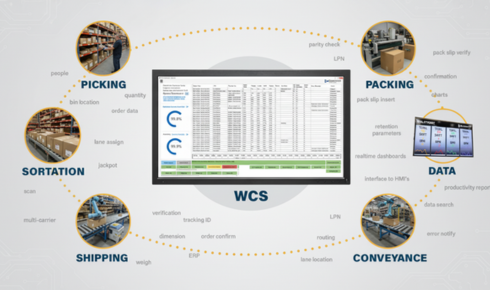In today’s fast-paced supply chain, efficiency and automation are critical to meeting customer expectations. Warehouses are no longer just storage facilities; they are smart hubs of real-time operations powered by automation. At the center of this transformation is the warehouse control system (WCS) – the software that ensures smooth and error-free execution of automated processes.
What Is a Warehouse Control System (WCS)?
A warehouse control system is a software layer that acts as the operational “brain” of your warehouse. Unlike a warehouse management system (WMS), which focuses on planning and inventory decisions, the WCS executes tasks in real time. It directly communicates with automation equipment such as conveyors, sorters, automated storage and retrieval systems (AS/RS), robotic shuttles, and palletizers to ensure everything runs without conflict or downtime.
In simpler terms, while your WMS tells the system what needs to be done (e.g., “pick this order”), the WCS decides how to make it happen (e.g., “route items via conveyor A, print labels, and sort them for outbound shipping”).
Key Functions of a WCS
A warehouse control system delivers several essential functions that keep operations moving seamlessly:
- Device orchestration – Manages conveyors, robotics, shuttles, and automated systems in real-time.
- Execution of tasks – Converts WMS instructions into step-by-step actions.
- Load balancing – Dynamically shifts workloads to prevent bottlenecks.
- Error handling – Detects jams, mis-scans, or system errors and reroutes items instantly.
- Performance monitoring – Provides real-time visibility of throughput and machine health.
How Does a WCS Work?
Think of a WCS as the command center for your warehouse automation. It connects directly to programmable logic controllers (PLCs), robotics software, and other device-level systems. This connection allows it to:
- Send real-time commands to equipment.
- Receive continuous feedback from devices like barcode scanners, weight checkers, and sensors.
- Respond instantly to disruptions (e.g., rerouting items when a sorter lane is jammed).
Example: In an e-commerce fulfillment center, a WCS might:
- Trigger the AS/RS to retrieve items from storage.
- Direct robotic shuttles to active picking zones.
- Coordinate conveyors to deliver items to a consolidation point.
- Activate label printing and sorting for outbound shipping.
- Reroute packages in case of scan errors or weight mismatches.
All of this happens seamlessly – without manual intervention.
WCS vs. WMS vs. WES: The Differences
Many businesses confuse warehouse automation software. Here’s a quick breakdown:
| System | Purpose | Focus | Users |
| WMS (Warehouse Management System) | Strategic planning of inventory, labor, and orders | Planning & reporting | Managers, supervisors |
| WCS (Warehouse Control System) | Real-time execution of tasks | Equipment coordination | Engineers, automation teams |
| WES (Warehouse Execution System) | Bridges WMS & WCS, optimizes flow | Task sequencing & load balancing | Operations planners |
In short: WMS plans, WCS executes, WES optimizes.
Benefits of a WCS in Modern Warehousing
Implementing a warehouse control system offers several benefits:
- Improved efficiency – Keeps equipment running without downtime.
- Real-time visibility – Provides insights into throughput and bottlenecks.
- Increased safety – Reduces manual intervention and risks.
- Scalability – Adapts to high order volumes or seasonal demand.
- Cost savings – Minimizes errors, delays, and manual labor costs.
The Role of PLCs in Smart Warehousing
A WCS becomes even more powerful when combined with Programmable Logic Controllers (PLCs). PLCs handle device-level automation like conveyor belts, robotic arms, guided vehicles, and barcode scanners. Together with WCS, they transform warehouses into smart, data-driven environments with:
- Real-time monitoring of equipment.
- Faster error detection and recovery.
- Improved accuracy and safety.
- Lower downtime and higher ROI.
Why Choose ControlSoft Canada for Warehouse Automation?
At ControlSoft Canada, we specialize in automation design, PLC programming, and real-time control systems that help warehouses achieve peak efficiency. With years of experience in automation integration, we deliver solutions that optimize throughput, reduce downtime, and support future scalability.
Conclusion
A warehouse control system is no longer optional, it’s the foundation of smart warehousing. By orchestrating devices, executing tasks in real-time, and integrating with PLCs, a WCS ensures your investment in automation delivers true value. Businesses that adopt this technology gain faster, safer, and more efficient operations that can adapt to today’s evolving supply chain challenges.


